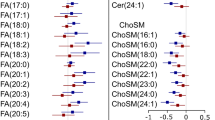Abstract
Androgens’ metabolism and activity are gaining a more and more important role in human physiology particularly referring to aging and to neurodegenerative diseases. Androgen treatment is often required for long-lasting disorders. In order to improve their duration and effects, androgens can be administered as esters of carboxylic acids. The novelty of our research is the use of esters of androgens with specific unsaturated fatty acids, in order to reduce possible side effects particularly related to chronic pathologies with altered lipid homeostasis such as X-linked adrenoleukodystrophy and cardiovascular disorders. Thus the esters of the main androgenic substances testosterone, dihydrotestosterone (DHT) and their metabolite 5α-androstan-3α,17β-diol were chemically obtained by coupling with different unsaturated fatty acids. To this aim, fatty acids with various degree of unsaturation and belonging to different series were selected. Specifically, oleic acid (18:1, n-9), linoleic acid (18:2, n-6), and the n-3 fatty acids, α-linolenic acid (18:3), eicosapentaenoic acid (EPA, 20:5), and docosahexaenoic acid (DHA, 22:6) were used obtaining corresponding esters with acceptable yields and good degree of purity. All the synthesized compounds were tested for their cytotoxic activities in mouse NIH3T3 and human astrocyte cell lines. The esters demonstrated good tolerability and no in vitro cytotoxic effect in both cell cultures. After these promising preliminary results, the esters will be suitable for in vivo studies in order to ascertain their pharmacokinetic characteristics and their biological effects.
Similar content being viewed by others
References
Masters WH, Johnson VE. Sex and the aging process. J Am Geriatr Soc 1981, 29: 385–90.
Kronenberg HM, Melmed S, Polonsky KS, Larsen PR. Williams Textbook of endocrinology. 9th ed. Philadelphia: Saunders, 2007, 819–76.
De Maddalena C, Bellini M, Berra M, Meriggiola C, Aloisi AM. Opioid-induced hypogonadism. Why and how to treat it. Pain Physician 2012, 15: ES111–8.
Vuong C, Van Uum SH, O’Dell LE, Lutfy K, Friedman TC. The effects of opioids and opioid analogs on animal and human endocrine systems. Endocr Rev 2010, 31: 98–132.
De Maddalena C, Vodo S, Petroni A, Aloisi AM. Impact of testosterone on body fat composition. J Cell Physiol 2012, 227: 3744–8.
Vanderschueren D, Vandenput L, Boonen S, Lindberg MK, Bouillon R, Ohisson C. Androgens and bone. Endocr Rev 2004, 25: 389–425.
Traish AM, Saad F, Feeley RJ, Guay A. The dark side of testosterone deficiency: III. Cardiovascular disease. J Androl 2009, 30: 477–94.
Kishimoto Y. Fatty acid esters of testosterone in rat brain: identification, distribution, and some properties of enzymes which synthesize and hydrolyze the esters. Arch Biochem Biophys 1973, 159: 528–42.
Hochberg RB. Biological esterification of steroids. Endocr Rev 1998, 19: 331–48.
Moser HW, Borel J. Dietary Management of X-linked adrenoleukodystrophy. Annu Rev Nutr 1995, 15: 379–97.
Assies J, Haverkort EB, Lieverse R, Vreken P. Effect of dehydropiandrosterone on fatty acid and hormone levels in patients with adrenoleukodystrophy. Clin Endocrinol 2003, 59: 459–66.
Petroni A, Cappa M, Blasevich M, Solinas M, Uziel G. New findings on X-linked Adrenoleukodystrophy: 5alpha-Reductase isoform 2 relative gene expression is modified in affected fibroblasts. Neurosci Lett 2004, 367: 269–72.
Vance DE, Vance JE. Biochemistry of Lipids, Lipoproteins and Membranes. 4th ed. Amsterdam: Elsevier, 2002.
Bang HO, Dyerberg J, Hjoorne N. The composition of food consumed by Greenland Eskimos. Acta Med Scand 1976, 200: 69–73.
Moya-Camarena SY, Vanden Heuvel JP, Blanchard SG, Leesnitzer LA, Belury MA. Conjugated linoleic acid is a potent naturally occurring ligand and activator of PPARalpha. J Lipid Res 1999, 40: 1426–33.
Banni S, Petroni A, Blasevich M, et al. Conjugated linoleic acids (CLA) as precursors of a distinct family of PUFA. Lipids 2004, 39: 1143–6.
Petroni A. Medicament based on a monoester of steroids with long chain fatty acids. EP patent 1962 856 B1, 2006.
Biological evaluation of medical devices. Part 5: Tests for in vitro cytotoxicity. ISO 10993-5: 2009.
Lamponi S, Leone G, Consumi M, Greco G, Magnani A. In vitro biocompatibility of new PVA-based hydrogels as vitreous body substitues. J Biomater Sci Polymer Ed 2012, 23: 55–75.
Venkata Rao P, Ramachandran S, Cornwell DG. Synthesis of fatty aldehydes and their cyclic acetals (new derivatives for the analysis of plasmalogens). J Lipid Res 1967, 8: 380–90.
Wood T, Jackson L, Baldwin AR, Longenecker EH. The preparation of some unsaturated fatty acid chlorides. J Am Chem Soc 1994, 66: 287–9.
Gould D, Finckenor L, Hershberg EB, Cassidy J, Perlman PL. Long-acting testosterone Esters. Some consideration on their biological utilization. J Am Chem Soc 1975, 79: 4472–5.
Nakanishi K, Okawa T. Method for preparing fatty acid chlorides. US patent 5912371, 1999.
Villeneuve GB, Chan TH. A rapid, mild and acid-free procedure for the preparation of acyl chlorides including formil chloride. Tetrahedron Lett 1997, 38: 6489–92.
Petroni A, Blasevich M, Uziel G. Effects of the testosterone metabolite dihydrotestosterone and 5alpha-androstan-3alpha,17beta-diol on very long chain fatty acid metabolism in X-adrenoleukodystrophic fibroblasts. Life Sci 2003, 73: 1567–75.
Liang T, Liao S. Inhibition of steroid 5alpha-reductase by specific aliphatic unsaturated fatty acids. Biochem J 1992, 285: 557–62.
Author information
Authors and Affiliations
Corresponding author
Rights and permissions
About this article
Cite this article
Aiello, F., Garofalo, A., Aloisi, A.M. et al. Synthesis of esters of androgens with unsaturated fatty acids for androgen requiring therapy. J Endocrinol Invest 36, 390–395 (2013). https://doi.org/10.3275/8655
Accepted:
Published:
Issue Date:
DOI: https://doi.org/10.3275/8655




